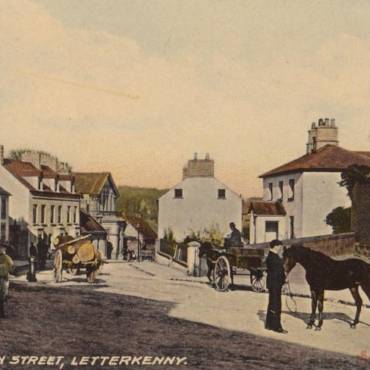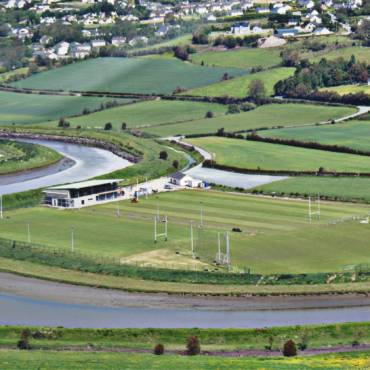ON THIS DAY: 14th June 1901: THE OPENING OF ST EUNAN’S CATHEDRAL
It was 115 years ago today that St. Eunan’s Cathedral in Letterkenny was officially consecrated and opened. Below is a short background in the lead up to that historic day.
Towards the end of the eighteenth century, with the repeal of the Penal Laws, the first known Catholic Church in the Letterkenny area had been erected on a site inside the northern gates of the present St. Eunan’s College. Thinking that it was too far away for town residents to get to though, by 1820, Fr. James Gallagher changed the location and erected a church on a site where the Cathedral presently stands. Ten years later, Bishop Patrick McGettigan built a larger church on the same site, although the need for a much larger building was recognized with the opening of St. Patrick’s Cathedral (or the pro-cathedral as it was later known) in 1854. By 1865 though, it was decided that a much larger Cathedral was needed for the ever-growing town. Following Bishop McGettigan’s death in 1861, it was his successor, Bishop Daniel McGettigan, who started the process by raising £500 for the construction of a Cathedral but the scheme had to be abandoned due to the depressed economic conditions at the time.
Under Bishop Michael Logue (1879-1888) the project was resurrected with large sums of money bequeathed to the building of a Cathedral by Neil Gillen (£11,000) and J.D. McGarvey (£10,000) but again, the project fizzled out due to economic hardship. However, when Bishop Logue became Cardinal in Armagh, the seat of the Bishopric of Raphoe became vacant and in 1888, the 32-year-old Fr. Patrick O’Donnell from Glenties became the youngest Catholic bishop in the world at the time. The task of building a Cathedral for the town was now in his hands.
In 1890, the Cathedral Building Committee was formed and Bishop O’Donnell called on generous people, especially of Irish descent, all over the world to help with the funding, as the construction would generate employment to people who needed it most. What Bishop O’Donnell wanted most of all though was:
“a building to gladden the hearts and ennoble the ideas of our downtrodden race, and remain for ages, not only a memorial, but a resurrection of the fallen shrines of Donegal”
William Hague was appointed architect and James McClay of Strabane was the builder. Archbishop Logue had laid the foundation stone in 1891, while rubble from the previous Pro-Cathedral was used for the foundations as a temporary church was built adjacent to the site. Boats transported the Mountcharles quarried stone to the Thorn where local farmers volunteered on Sundays to cart them the several miles to the building site. When they got to the bottom of the Church Lane, 1/3 of the cargo was unloaded, to be taken up on a second trip. The stones for the spire were then raised by sets of horses pulling ropes to the desired height.
James McClay went out of business in 1895 and so Fr. Stephens was recalled from America to supervise the completion of the building while in 1899, the architect William Hague died and was succeeded by his colleague Thomas Francis McNamara. Hague’s work was later commemorated by having a stained glass window of St. William placed in the cathedral in his honour, located on the left hand side of the aisle.
By June of 1901 the new Cathedral was ready for opening. People came from all parts of Ireland, England, Scotland, America, Australia and New Zealand to witness this wonderful occasion for the town of Letterkenny and the overall Diocese of Raphoe. The consecration took place on Friday June 14th by Cardinal Logue while the first mass took place at 11 o’clock on Sunday June 16th 1901. Various festivities throughout the town followed this with the bells ringing throughout the day and music performances into the early evening. At 10pm, fireworks were set ablaze for over two hours. The Derry Journal describes vividly the vibrant atmosphere in the town that weekend:
“Yesterday an historic scene – a great celebration – was witnessed in Letterkenny that stirred the feelings, influenced the minds eye and touched the hearts of all beholders…In the early morning the town was alive with preparation, gay with hope and outward cheer… Hearty words of greeting streamed from every side and the whole effect and display exhibited the feelings and warmth of a populace who greeted in enthusiastic welcome those numerous visitors who crowded the town.”
Large triumphal floral arches greeted the visitors throughout the town, with flags fluttering from houses and trees. Outside the railway station, a large floral semi-circular span had the greetings “Céad Mile Fáilte” and “Welcome to the Cardinal and Hierarchy of Ireland” while on the Main Street, an arch outside McCarry’s Hotel, had “Eire go brath”, “Tir agus credimh” and “Stay long, return soon”. The houses and footpaths of the town were one continuous line of flags, bunting, banners and decorations.
Over the ten years it took to complete the construction, the final cost of the Cathedral was over £300,000 (approximately €20.5 million today). At the time of its opening in 1901, a book entitled “An Illustrated Guide to Saint Eunan’s Cathedral” stated:
“The Cathedral cost much money, much thought, much anxiety, much sacrifice, but no life, thank God. It was meant as a “resurrection of the fallen shrines of Donegal”. It is that, and more, Letterkenny is not a large town, but the scattered children of Tirconnail are a numerous race, with the same virtues, ideals and inclinations that were theirs in the past. Henceforth the Cathedral is a rallying point, a source of inspiration, a common joy and a common inheritance for them all.”


